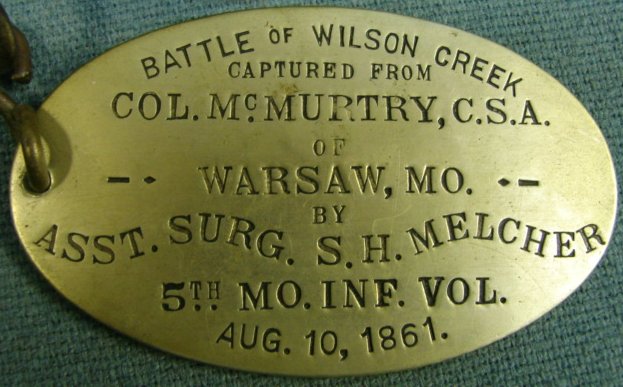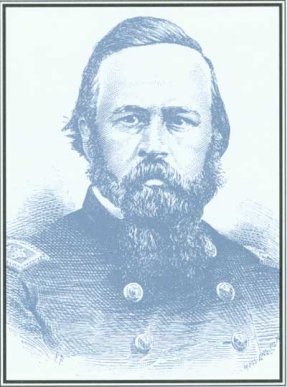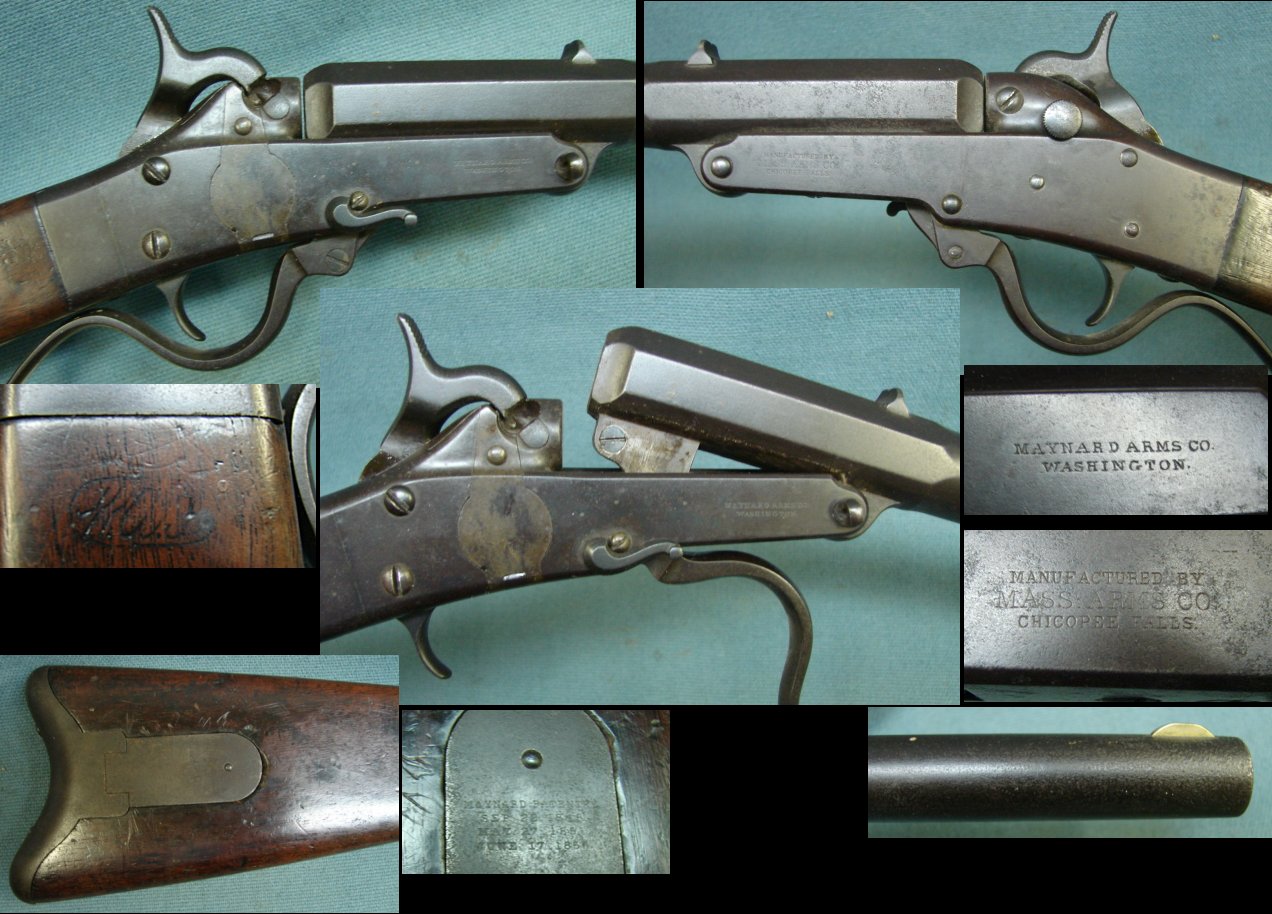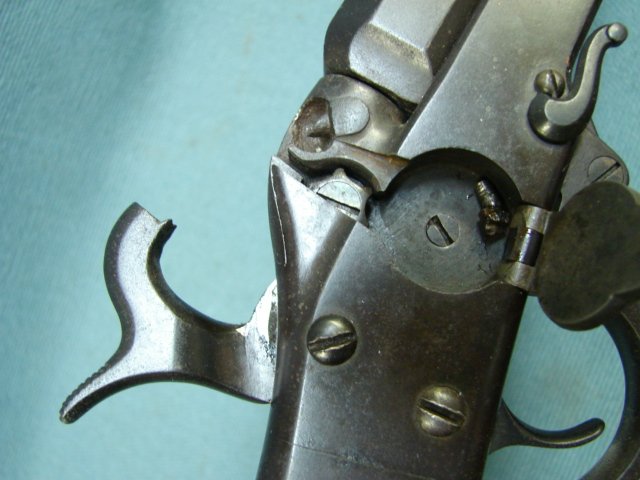Spotlight Item!
Ordering
Information- click here.
Return to Collectors
Headquarters.
ANTIQUE FIREARM- no FFL needed!

HISTORIC CIVIL WAR SADDLE RING CARBINE!
Rare- One of only 400 purchased by the U.S. Ordnance Department
Confederate used- by Col. John McMurtry, 8th Division Missouri State Guard (CS)
Battle captured- Wilson’s Creek, MO, August 10, 1861 (near Springfield, MO)
Identified captor- Asst. Surgeon Samuel H. Melcher, 5th Missouri Volunteer Infantry (US)
Melcher’s capture of “Maynard carbine” from Col. McMurtry is documented in his account of the battle.
 .
. 
Dr. Samuel H. Melcher, and the tag on the carbine he captured
$5,500.00 including insured shipping in the U.S.
Ordering
Information- click here.
The battle of Wilson’s Creek, near Springfield, Missouri, took place August 10, 1861, exactly 150 years ago this month. It was a real example of how the Civil War divided communities, and sometimes involved residents of the some state fighting against each other under Union or Confederate flags, and how early units were often mistaken for friend or foe due to haphazard uniforms, and the problems of the “90 day volunteer” units as fighting forces. Much more on the Battle of Wilson's Creek is on the National Park Service site at http://www.nps.gov/history/history/online_books/civil_war_series/26/sec9.htm

MAYNARD AND HIS GUNS
Dentist Edward Maynard designed a breechloading carbine where opening a lever on the bottom moved the barrel up and away from the breech for loading. It used a metallic cartridge, basically a piece of brass tubing with a disc soldered to the base with a small hole in the center of the disc. Powder and a bullet were placed in the cartridge case, and they were easily loaded into the breech, and extracted after firing. Ignition was from a percussion cap placed on a nipple at the breech, where the flame could pass through the breech and the hole in the cartridge case to ignite the powder charge. Maynard is best known for his patented the use of “tape primer” mechanisms which used something similar to a roll of cap gun caps which would be advanced one dot every time the hammer was cocked, and poised over the nipple, eliminating the need to fumble with individual percussion caps for each shot, and the tape primer system was included in his early carbines. The Maynard tape primer system was used on SPringfield Armory Model 1855 rifles, pistols and rifle muskets, and also for covnerting Model 1816 .69 caliber muskets, and on several other contract arms.
Maynard sold 400 of his “First Model” carbine to the U.S. Army, delivering them in March 1859 and Flayderman states they were sent to the St. Louis Arsenal. Some were issued to regular troops prior to the Civil War, mainly those headed west to fight Indians. Eventually those still on hand were issued to various units during the Civil War. With only 400 purchased, this is one of the scarcest of all Civil War saddle ring carbines. This one has a faint, but legible WAT inspection cartouche on the right side of the stock, for W.A. Thornton, ordnance inspector at the time. Exactly how this ended up in the hands of Confederate Colonel John McMurtry is uncertain, but probably it was either pilfered from the St. Louis Arsenal by rebel sympathizers, or perhaps obtained somehow from one of the early units they had been issued to during their march westward, or taken among the 1,500 small arms captured by state forces as the small U.S. Arsenal at Liberty, MO, on April 20, 1861. Including civilian sales and a few sales to southern states, a total of about 5,000 of the “first model” Maynards were made. In 1863 delivery began of about 20,000 of the familiar second model Maynard carbines, without the tape primers, and these were well regarded arms.
CONFEDERATE COLONEL MCMURTRY
John McMurtry, born about 1822 in Virginia, was a resident of Warsaw, MO, in 1860 where the census listed him as a farmer with $2300 in real estate and $31,919 in personal estate, hugely wealthy under the standards of the day, and more likely what we would think of as “plantation owner” not “farmer.” He was married with one child.
DIVIDED LOYALTIES IN 1861 MISSOURI
In 1860, the Missouri governor, Claiborne Jackson, a strong southern sympathizer, made it clear he would stand with the south, consistent with the beliefs of many rural Missourians, who had been supportive of the “Border Ruffians” and other pro-slavery activities in neighboring “bleeding Kansas” for several years.
However, the urban population of St. Louis, mostly ethnic German immigrants, were strongly opposed to slavery, and by the time of Lincoln’s inauguration and the firing on Fort Sumter, pro and anti-slavery militia units were being formed around the state, with the latter mostly from St. Louis.
GENERAL NATHANIEL LYON, THE ST. LOUIS ARSENAL AND UNION TROOPS
The 16,000 man U.S. Army was widely scattered, mostly in small detachments across the west and manning seacoast fortifications, so on April 15, 1861, Lincoln called for 75,000 volunteers to serve 90 days to put down the rebellion. Missouri’s governor refused to muster any troops, and Captain Nathaniel Lyon whose company of the 2nd U.S. Infantry had been rushed to secure the St. Louis Arsenal, was authorized to raise four volunteer infantry regiments from the St. Louis area, and also to transfer arms from the Arsenal to Illinois volunteers to secure the area for the Union.
Lincoln then directed Lyon to raise another “90 Day” regiment, the 5th Missouri Volunteers, in May, 1861, and it was this unit that Samuel Melcher joined as Assistant Surgeon. On May 17, 1861, Lyon, who had been an officer since graduation from West Point in 1841 but only a Captain in the slow promotion of those times, was promoted to Brigadier General and given command of Union forces in Missouri.
As General Lyon, he took some of his newly raised forces and struck at rebel forces assembling at Camp Jackson near St. Louis, seizing arms while killing 28 and wounding 75 civilians/rebels. This provoked riots and drove rebel sympathizers into open rebellion, but was praised by Union sympathizers as slowing the spread of the rebellion. Lyon then declared war on the Governor and his Missouri State Guard forces, chasing them from the Capitol at Jefferson City, and defeating some at the Battle of Booneville, and chasing the remainder into southwest Missouri.
MISSOURI REBEL FORCES
Meanwhile, the Governor had mobilized Missouri State Guard troops, organized into traditional “divisions” designated from the Congressional Districts into which the state was divided. John McMurtry was on the 8th Division staff as Quartermaster with rank of Colonel, befitting his wealth and connections, supporting five infantry regiments and two cavalry regiments. These troops missed the earlier Camp Jackson episode and the Battle of Booneville, but were engaged at the fighting in the Springfield campaign, culminating in the Battle of Wilsons Creek. Col. McMurty was there with his Division for this campaign.
UNION ASSISTANT SURGEON SAMUEL H. MELCHER
Samuel Henry Melcher was born in Gilmanton, NH, October 30, 1828, and after becoming a medical doctor via Dartmouth College and training in Boston, he
traveled South and through Texas; and [in 1859] settled in Potosi, Washington county, Missouri. Upon start of the war, he volunteered his services to Gen. Lyon, at St. Louis arsenal; and was mustered in as assistant surgeon 5th Regiment of Missouri Volunteers (90 Day) on May 7, 1861.
Melcher was with his unit at the battles of Carthage, July 5, 1861; Dug Spring, August 2, 1861; Wilson's Creek, August 10, 1861, where he was the last officer on the field after the forces fell back, and brought off the body of Gen. Lyon before remaining on the field to care for wounded Union troops captured by the Confederates. (More about this below.)
Note that the 90 day enlistments had expired for many of the volunteers, but Lyon had convinced them to serve for another week or 10 days, just long enough to participate in Wilson’s Creek battle.
After his service in the Confederate lines caring for Union wounded, Melcher reenlisted as Brigade Surgeon in the new volunteer units and filled a variety of medical assignments running hospitals and the like, before being assigned as Colonel of the home guard type “32nd Enrolled Missouri Militia” which dispersed the guerilla bands in Washington and adjoining counties, captured several rebel mails, and large quantities of arms, horses, and medical stores. In October 1862 he returned to medical duty and was able to rally some 400 patients from the hospital at Springfield to successfully defend the town against a rebel attack.
In May 24, 1863, Melcher again strayed from healing to fighting, and was commissioned Lieutenant Colonel of the 6th Cavalry Missouri State Militia, and assigned to duty as assistant inspector general of the Department of the Missouri, and served in this capacity until Price's raid in 1864, when he was ordered to the field as aid-decamp to Gen. Alfred Pleasanton, commanding the cavalry. In his report of the destruction of Price's army, Gen. Pleasanton mentioned Col. Melcher for "gallantry and fidelity." Col. Melcher went on to command the post at Jefferson City, until he resigned December 24, 1864. After the war, in failing health with vision and headache problems, he served in the Freedman's Bureau. Later he was given sinecure positions at the U. S. Marine Hospital, St. Louis, and the State Lunatic Asylum. Later he moved around to Chicago, then the Dakotas, and finally died in Chicago in 1915.
When researching this, we were astounded to discover that our ArmsCollector.com site had a great piece on Melcher and a sword that was presented to him for his service at one of the hospitals! Check it out at http://armscollectors.com/mgs/missouri_sword.htm
MELCHER CAPTURES McMURTRY’S MAYNARD CARBINE
The details of the confusion at the Battle of Wilson’s Creek are well documented in various accounts of the battle, with difficulty telling friend from foe due to lack of uniforms, greatly compounding the problems of virtually untrained troops engaging the enemy. Fortunately, Dr. Melcher’s own account of the battle was published, and can be read on line at http://thelibrary.org/lochist/history/paspres/ch11pt3.htm [Search for “A Personal Account” in Jonathan Fairbanks and Clyde Edwin Tuck, Past and Present of Greene County Missouri: Early and Recent History and Genealogical Records
of Many of the Representative Citizens or page 278 of the printed edition. Melcher’s account states specifically:
“The Fifth Missouri was in reserve, except Company K, under Capt. Samuel A. Flagg, which was farther in the rear, guarding some thirty or forty prisoners. At this juncture I captured Colonel McMurtry, of Warsaw, Benton county, Missouri, an officer in Price's army. I took his Maynard carbine, two pistols and his sword, turning the three latter weapons over to two musicians of the Fifth Missouri, but retained the carbine. Later Colonel McMurtry escaped by representing himself to be a Confederate surgeon.”
This carbine has an old German Silver(?) tag attached to the saddle ring reading:
BATTLE OF WILSON CREEK
CAPTURED FROM
COL McMURTRY, C.S.A.
of
WARSAW, MO.
BY
ASST. SURG. S.H. MELCHER
5th MO. VOL. INF.
AUG. 10, 1861.
This information on the metal tag attached to the carbine is corroborated by the documentary account cited above. Although no serial number is mentioned, (nor could we find one on the gun anyway), we know for sure that Melcher was there and captured a Maynard carbine from Col. McMurtry. We also know that relatively few First Model Maynard carbines were purchased by the Army, and that they were shipped to the St. Louis Arsenal and thus likely to be the source for McMurty to get one, albeit by unknown (and likely unauthorized) means. Exactly when the tag was added is unclear, but our best guess is that it was probably done at some point by Melcher family members to preserve the history, or possibly by some small museum.
CONDITION OF THE GUN
Overall this is a brown gun with no original external finish, just mostly brown patina, with some light pitting near the muzzle. The bore is very good. The walnut buttstock has assorted dings and scrapes of an issued (and captured) arm, but has never been sanded and the WAT inspector cartouche is faint but legible. This has never had a tang sight as was done on some of the civilian sale guns. The nipple was broken long ago and looks like an oddball size, probably peculiar to this model. The feed mechanism for the primer tape is inoperative, and there is a tiny screw that has fallen into the tape recess from the lock guts which probably accounts for the problem, but we have no idea how these work, so have not fiddled with it. Otherwise this is in sound mechanical condition. While this is not a gun for the fanatical condition collector, this is a great gun for people who appreciate history and the relics that help tell the story.

This is a rare gun to start with, and the history of usage by a Confederate Colonel and capture in battle by a colorful Union officer/doctor exactly 150 years ago adds immensely to its desirability.
Price $5,500.00 including shipping in the U.S.
Ordering
Information- click here.